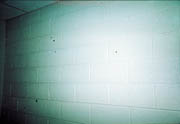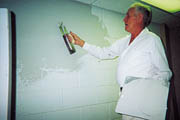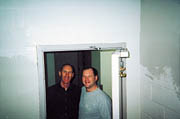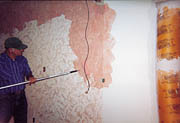

There are several problems and situations where re-surfacing can help. #1: It can cover over a multitude of “sins,” ugly work, texture that is “too thick” and that the homeowner now wants to get rid of, or smoothing out “block-type” walls; #2: For older homes, including historic sites where cracks are appearing all over the surface on walls and ceilings; and #3: Ceilings where the popcorn or texture is removed and the homeowner now wants smooth or another type of finish applied. Let’s consider the “photo gallery” now.

Into the gallery
Our first example (picture #1) is a block wall. This was located in Romeoville, Ill., where we were called in to smooth it out for wallpaper. The first step in re-surfacing is to make sure the wall or ceiling is clean and grease- or dirt-free. The next step is to apply a bonder (these vary from a clear solution to ones “pink” in color).Picture #2 shows Marvin Newman (45 years in the business) applying the basecoat. We applied the first layer of basecoat, then doubled back with a second out of the same batch. This was followed by a thick, smooth coat that was also applied in a two-layer procedure all from the same batch. This was then troweled to a smooth finish. Picture #3 shows me visiting with Roy O’Bryan who was happy to see the block walls go!
Our second example shows bonder being applied to the walls and ceilings (pictures #4 and #5). In #4 you will notice that the back of the stage area was a very, very heavy texture. Picture #6 shows the technique used on this: A thick first coat was applied and allowed to set. It took about 15 minutes to run the first coat on the entire stage area; it chemically set up about a half hour later. We then followed it up with a second layer of plaster.
If a really heavy texture is to be covered, it is best to run it in two or three separate batches like this. If built out too thick, the mud has a tendency to “slide” or “sag” down with the weight. Separate batches and layers solve this.
In our project, we then followed with a smooth coat. Picture #5 shows the ceiling where popcorn was removed and the surface sustained some nick and tear damage. We applied bonder and a basecoat. This set up in about an hour and a half, and then we were ready for the sand finish coat.
Several plasterers followed up by floating the ceiling with sponges and creating a random swirl texture.

Tips for the artist
It’s good when re-surfacing to check the label to see how far in advance you can apply bonder before plastering. It can’t be put on weeks in advance. I personally like to put it on the day before or the morning of the day I’m going to be plastering. If you are in a hurry (or in an area where there is little air movement, like in a small, unvented bathroom) a fan can be positioned to blow directly on the ceiling to help it dry. This will usually take less than an hour.It is important that the bonder is applied over the entire surface to be plastered. If it does not get a thorough coverage, areas can literally “pop off” the portions that were not bonded. This is a point I can’t overemphasize! I use a small trim brush to apply it in the angles and a paint roller (1/2-inch nap on smooth surfaces, 3/4 inch on heavy textured surfaces) to roll the bonder on. With the tinted bonders, you can tell more easily if you skipped a spot. With the clear types, it’s harder.
I shine a light across the area or look in good sunlight and the areas that were missed will appear “dull.” The areas you bond will have a “sheen” to them. This is very important, especially on heavy textured surfaces. The bonder must get into all the little areas that can be easily missed if done too fast.
As in all projects, make sure the areas around where you’re bonding are protected. One splash of bonder can cause a disaster that sometimes cannot be fixed. Another tip is to lay down thin plastics over your drop cloths and then apply the bonder. Any splashes and drops that come down will land on these and you can then roll these up and throw them away. This will help you from tracking bonder through the house. This extra effort will make you feel better about working on the project and will make the homeowner or contractor you’re working for grateful you showed such care for the property you’re working on. Neatness is a top priority when working with bonder.
If you have any other questions or comments about bonding, or a project you are working on and need assistance on, just drop me a line via the magazine, or visit with me at www.wconline.com on the bulletin board. I’m leaving comments on questions that are found there, as well.
Until next time, may your profits be high and your overhead be low! Thanks again for your letters! They are always appreciated!



Report Abusive Comment